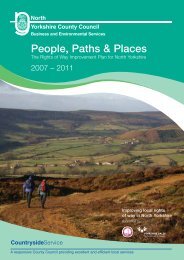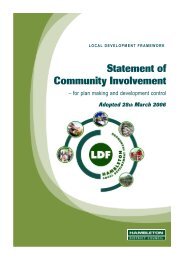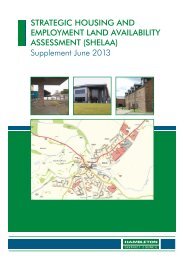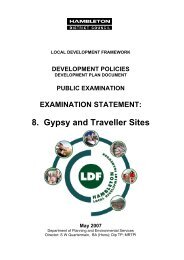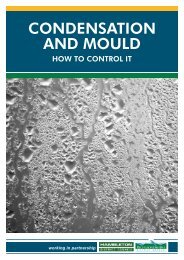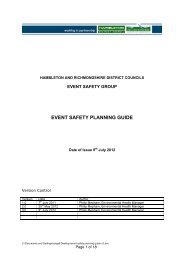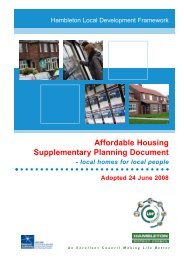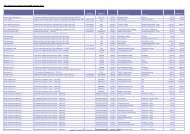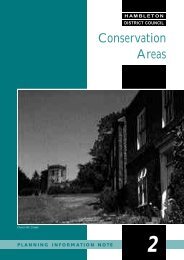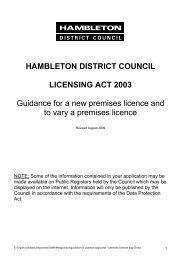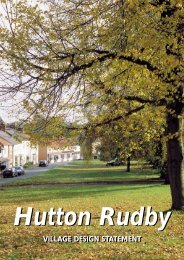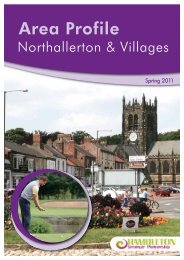Strategic Flood Risk Assessment - Hambleton District Council
Strategic Flood Risk Assessment - Hambleton District Council
Strategic Flood Risk Assessment - Hambleton District Council
Create successful ePaper yourself
Turn your PDF publications into a flip-book with our unique Google optimized e-Paper software.
THIRSK AREA<br />
• Thirsk & Sowerby<br />
Background<br />
Thirsk and Sowerby are situated on a gently sloping landscape with slightly elevated ground<br />
to the north and lower ground to the south. The area has been subject to significant flooding<br />
on average every 25 years, with smaller scale events in between.<br />
Cod Beck and Whitelass Beck are the main influences on flooding in Thirsk and Sowerby.<br />
The higher risk <strong>Flood</strong> Zone 3 areas are concentrated alongside these watercourses and<br />
extend into some existing residential areas as well as the town centre. The <strong>Flood</strong> Zone 2<br />
areas are more extensive and cover large areas of Old Thirsk and the Industrial Park on the<br />
eastern side of the Cod Beck.<br />
Following the November 2000 flooding the Environment Agency carried out a Section 105<br />
study of flooding that affects Thirsk. Following this <strong>Hambleton</strong> <strong>District</strong> <strong>Council</strong> commissioned<br />
a two stage feasibility study to determine whether an economically viable flood alleviation<br />
scheme could be provided for Thirsk. The feasibility study indicated that under the DEFRA<br />
flood management grant aid funding criteria for 2005/06 it should be possible to provide an<br />
economically viable flood alleviation scheme for Thirsk, and proposed a scheme based on a<br />
rural water storage area combined with minimal flood defences alongside the Cod Beck<br />
where it flows through the urban area.<br />
Due to its strategic importance the Environment Agency are planning to enmain the Cod Beck<br />
in April 2006. This will mean it is given main river status and will come under the supervisory<br />
responsibility of the Environment Agency. Once this takes place only the Environment Agency<br />
will be able to carry out flood protection works on the watercourse. Presently whilst the<br />
watercourse retains ordinary watercourse status flood protection works fall to the Local<br />
Authority or the Cod Beck Internal Drainage Board.<br />
<strong>Flood</strong>ing<br />
The <strong>Flood</strong> Zone 3 areas to the north and south of existing development largely extend over<br />
natural floodplain or washlands. Development of these areas should be avoided. The <strong>Flood</strong><br />
Zone 3 area extents also affect both brownfield and greenfield land within the existing<br />
developed areas alongside the Cod Beck,<br />
The <strong>Flood</strong> Zone 2 areas extend over a wider area of Thirsk and in some instances to<br />
greenfield land adjacent to existing development to both the north and south of the<br />
settlement. .The presence of the <strong>Flood</strong> Zone 2 areas does not wholly preclude development,<br />
but does place restrictions on development subject to the sequential test set out in PPG25.<br />
Additional areas of flood risk have not been identified.<br />
See plans on pages 60-64<br />
• Carlton Miniott<br />
Background<br />
Carlton Miniott is situated on an almost flat landscape. There are no <strong>Flood</strong> Zone 2 and 3<br />
areas within the village, though there are a number of small drainage channels and<br />
watercourses that flow from south to north through the village and a number of large ponds<br />
close to residential areas.<br />
27



